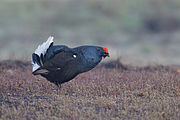Lyrurus
Appearance
| Lyrurus Temporal range:Early Plioceneto recent
| |
|---|---|

| |
| Black grouse(Lyrurus tetrix) | |
| Scientific classification | |
| Domain: | Eukaryota |
| Kingdom: | Animalia |
| Phylum: | Chordata |
| Class: | Aves |
| Order: | Galliformes |
| Family: | Phasianidae |
| Tribe: | Tetraonini |
| Genus: | Lyrurus Swainson,1832 |
| Type species | |
| Tetrao tetrix(black grouse) Linnaeus,1758
| |
| Species | |
Lyrurusis a genus of birds in thegrousesubfamily. They are known as black grouse because the male'splumageof both species is coloredblackas its base colour.
Taxonomy
ThegenusLyruruswas introduced in 1832 by the English naturalistWilliam John Swainsonwith theblack grouseas thetype species.[1]The genus name combines theAncient Greeklurameaning "lyre" with-ourosmeaning "-tailed".[2]
Species
The genus contains two species:[3]
| Common name | Scientific name and subspecies | Range | Size and ecology | IUCN status and estimated population |
|---|---|---|---|---|
| Black grouse | Lyrurus tetrix (Linnaeus, 1758) |
Europe (Swiss-Italian-French Alps specially) from Great Britain (but not Ireland) through Scandinavia and Estonia, eastwards through Russia and parts of Kazakhstan, Mongolia, and China
|
Size: Habitat: Diet: |
LC
|
| Caucasian grouse | Lyrurus mlokosiewiczi (Taczanowski, 1875) |
TheCaucasus,specifically theCaucasus Mountains | Size: Habitat: Diet: |
LC
|
References
- ^Swainson, William John;Richardson, J.(1831).Fauna Boreali-Americana, or, The Zoology of the Northern Parts of British America.Vol. Part 2. The Birds. London: J. Murray. p. 497.The title page bears the year 1831 but the volume was no published until 1832.
- ^Jobling, James A. (2010).The Helm Dictionary of Scientific Bird Names.London: Christopher Helm. p. 233.ISBN978-1-4081-2501-4.
- ^Gill, Frank;Donsker, David;Rasmussen, Pamela,eds. (July 2021)."Pheasants, partridges, francolins".IOC World Bird List Version 11.2.International Ornithologists' Union.Retrieved23 August2021.






